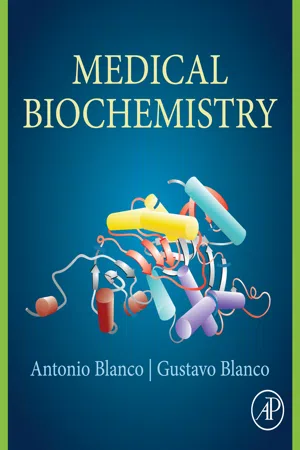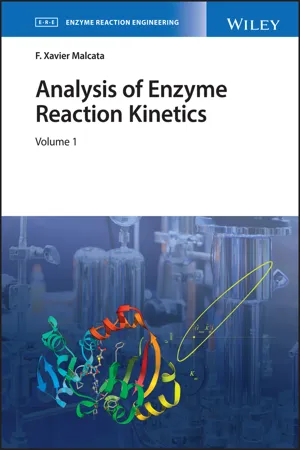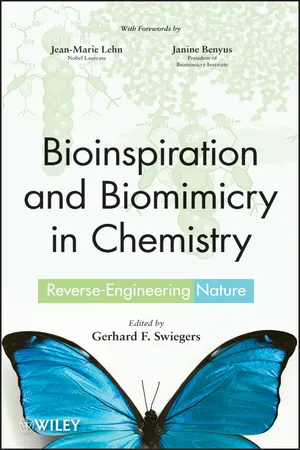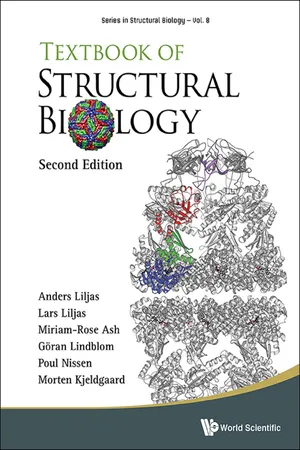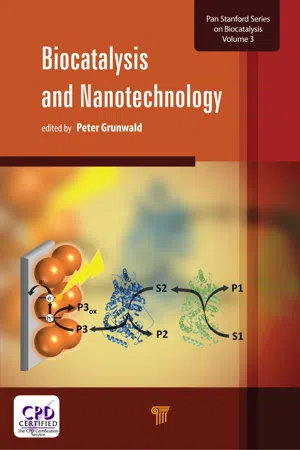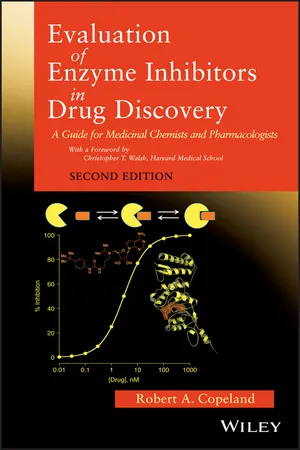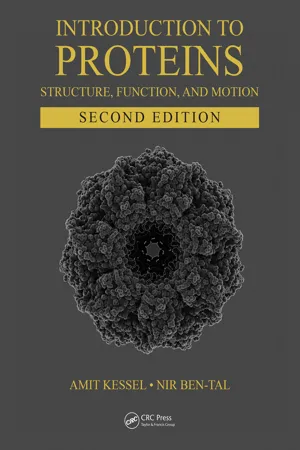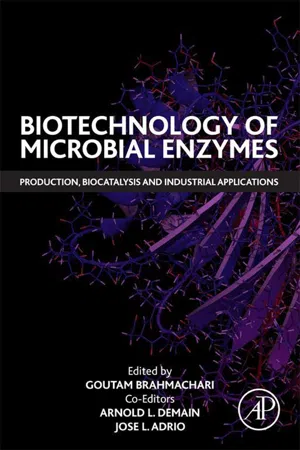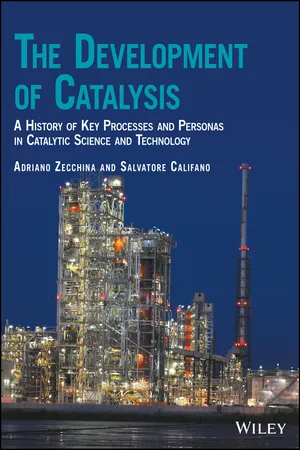Chemistry
Enzymes as Biocatalysts
Enzymes are biological catalysts that accelerate chemical reactions in living organisms by lowering the activation energy required for the reaction to occur. They are highly specific, often catalyzing only one type of reaction. Enzymes are essential for various metabolic processes, and their activity can be influenced by factors such as temperature and pH.
Written by Perlego with AI-assistance
Related key terms
Related key terms
1 of 4
Related key terms
1 of 3
11 Key excerpts on "Enzymes as Biocatalysts"
- eBook - ePub
- Antonio Blanco, Gustavo Blanco(Authors)
- 2017(Publication Date)
- Academic Press(Publisher)
Countless chemical reactions take place at a given time in every living being. Many of them transform exogenous substances, which come with the diet, to obtain energy and the basic materials that will be used for the synthesis of endogenous molecules.Biochemical transformations are performed at a remarkable fast rate and with great efficiency. To reproduce them in the laboratory, these reactions would need extreme changes in temperature, pH, or pressure to take place; these changes are not compatible with cell survival. Under normal physiological conditions (37°C for warm-blooded organisms, pH near neutrality, and constant pressure), most of the reactions would proceed very slowly or may not occur at all. It is the presence of catalysts that allow chemical reactions in living beings to occur with great speed and under the mild conditions that are compatible with life.Enzymes are biological catalysts
A catalyst is an agent capable of accelerating a chemical reaction without being part of the final products or being consumed in the process. In biological media, macromolecules called enzymes act as catalysts.As any catalyst, enzymes work by lowering the reaction activation energy (A e ) (see p. 152). Enzymes are more effective than most inorganic catalysts; moreover, enzymes show a greater specificity of effect. Usually inorganic catalysts function by accelerating a variety of chemical reactions, whereas enzymes catalyze only a specific chemical reaction. Some enzymes act on different substances, but generally, these are compounds with similar structural characteristics and the catalyzed reaction is always of the same type.The substances that are modified by enzymes are called substrates .The specificity of enzymes allows them to have high selectivity to distinguish among different substances and even between optical isomers of a compound. For example, glucokinase, an enzyme that catalyzes d -glucose phosphorylation, does not act on l - eBook - ePub
- F. Xavier Malcata(Author)
- 2023(Publication Date)
- Wiley(Publisher)
1 Introduction1.1 Basic Concepts
Enzymes are the functional units of cell metabolism; these globular proteins with catalytic features possess high activity toward their substrates, at mild operating conditions – which makes them particularly attractive to support clean technologies of chemical processing. Because of the decreasing trend in cost of manufacture of enzymes from microbial sources, those biocatalysts are now available for industrial purposes at higher and higher quantities – and with higher and higher purities, at affordable prices. Hence, enzymes have enjoyed a remarkable growth in associated knowledge, owing to their relevant contributions to such widespread activities as brewing, fruit juice clarification, dry and detergent cleaning, and analytical determinations.As catalysts, enzymes bring about increases in the rate of biochemical reactions without undergoing permanent chemical change themselves; however, such an efficiency usually requires interaction between enzyme and substrate molecules via formation of intermediates with chemical identity. On the other hand, the reactions they catalyze are far from instantaneous – yet the time they take to occur depends on the pathway followed by enzymes to accelerate them. Therefore, the usefulness of rate expressions relating the evolution in concentration of substrate(s) with time – based on postulated intermediates, should reflect the best balance between simplicity and accuracy toward bioprocess engineering at large. The first step is obviously reactions encompassing a single substrate – or run at conditions that mimic a single substrate; multisubstrate enzymatic reactions will thus be left for later discussion.Despite its lack of general applicability to enzyme‐catalyzed reactions due to the underlying simplifying assumptions, unisubstrate rate expressions have conquered a status of reference – and are accordingly useful to compare performance between enzymes in general. The (relative) simplicity in mathematical form of the said rate expressions is probably their major asset – coupled to their mutual resemblance, in terms of asymptotic behaviors predicted and underlying chemical meaning of the very few kinetic parameters at stake. To fully grasp their impact and provide a better scientific framework, a historical perspective is put forward – and further refinements are mentioned, for the sake of completeness. - eBook - ePub
Bioinspiration and Biomimicry in Chemistry
Reverse-Engineering Nature
- Gerhard Swiegers, Gerhard Swiegers(Authors)
- 2012(Publication Date)
- Wiley(Publisher)
Chapter 7: Bioinspired Catalysis Gerhard F. Swiegers, Jun Chen and Pawel Wagner7.1 Introduction
Catalysts are species that accelerate chemical reactions without themselves being consumed in the process. The most efficient catalysts by far are the catalysts of biology, known as enzymes. The maintenance and creation of life in all its many and varied forms on Earth depends on the ability of enzymes to speed chemical transformations in biochemical systems. To this end, enzymes often display truly amazing vigour, specificity, and reliability. The fact that life itself depends on the action of enzymes testifies to their remarkable power.To illustrate enzymatic capacities, it is worth considering that a single example of the enzyme carbonic anhydrase has the capacity to convert 600,000 CO2 molecules per second in our muscles into H2 CO3 in our blood.1, 2 It can do this repeatedly, without fail, at body temperature (37° C) in the extraordinarily mixed reactant feedstock that is a biological fluid, and at a CO2 partial pressure of ≤ 1 atmosphere.1, 2 Moreover, it selectively transforms CO2 in the presence of a wide variety of other possible reagents without becoming deactivated.By comparison, modern industrial catalysts are rudimentary in their operation. For example, the economically important Haber–Bosch process for the production of ammonia from nitrogen and hydrogen typically requires temperatures of 500 °C with the reagent gases compressed to 1000 atmospheres. Despite these extremes, ammonia is generated in only 15–25% yield. The catalyst, a heterogeneous iron and oxide mix, must be replaced periodically because it is poisoned by even miniscule impurities in the feedstocks.How do enzymes achieve such feats? More pertinently, how can we replicate them?Because of the remarkable versatility and efficiency of enzymes, understanding and applying Nature's catalytic principles in nonbiological systems is exceedingly important. Ronald Breslow of Columbia University outlined it as one of the Holy Grails of chemistry in a landmark 1995 scientific publication in the journal Accounts of Chemical Research.3 He coined the term biomimetic chemistry, which is defined as3 - eBook - ePub
A Study of Enzymes
Enzyme Catalysts, Kinetics, and Substrate Binding
- Stephen A. Kuby(Author)
- 2019(Publication Date)
- CRC Press(Publisher)
Chapter 1Historical Introduction, Theories of Enzyme Catalysis, and some Elementary Considerations of Enzyme Kinetics
I. Introduction
Any understanding of other branches of biochemistry ultimately depends, to a large degree, on some knowledge of the nature, properties (both physical and chemical), and actions of the enzymes, which in turn are responsible for the rate of chemical changes which occur in all living organisms. The myriad of reactions and chemical pathways involved in the intermediary metabolism of protein, fat, and carbohydrate and the intricate chemical reactions concerned with the energetics of the cell are mediated through protein catalysts. Many physiological processes such as muscular contraction, blood clotting, excretion, de-toxication, digestion, etc. are intimately linked with the chemistry of the cell, which invariably hinge on enzymatically catalyzed reactions. To quote Dixon,9 “Life depends on a complex network of chemical reactions brought about by specific enzymes, and any modification of the enzyme pattern may have far-reaching consequences for the living organism …”Enzymes are biocatalysts and as such their function is to influence the rates of chemical reactions. If they act as true catalysts, not the chemical equilibria; they may increase the rate of a particular chemical reaction, but ideally they do not influence the final equilibrium concentrations of reactants and products. However, in several notable cases where investigations were made under conditions where the enzyme concentration was not catalytic, but on the contrary, stoichiometric with respect to the substrate, the final state of the system was shown to be influenced by the enzyme protein concentration. Thus, the enzyme molecule exerts its effective catalytic function by participating directly in the reaction as if it were a reactant. In general, however, where concentrations of enzymes are employed which are several orders of magnitude below that of the substrate(s), the enzyme approaches a true catalyst in nature, and, under these conditions, influences only the rates of chemical reactions and not the final equilibrium state. - eBook - ePub
- T. D. H. Bugg(Author)
- 2012(Publication Date)
- Wiley(Publisher)
Chapter 3 Enzymes Are Wonderful Catalysts 3.1 IntroductionThe function of enzymes is to catalyse biochemical reactions. Each enzyme has evolved over millions of years to catalyse one particular reaction, so it is perhaps not surprising to find that they are extremely good catalysts when compared with man-made catalysts.Figure 3.1 Rate acceleration of glycoside hydrolysis by intramolecular and by enzyme catalysis.The hallmarks of enzyme catalysis are: speed, selectivity and specificity. Enzymes are capable of catalysing reactions at rates well in excess of a million-fold faster than the uncatalysed reaction, typical ratios of kcat /kuncat being 106 –1014 . Figure 3.1 shows an illustration of the speed of enzyme-catalysed glycoside hydrolysis. The rate of acid-catalysed glycoside catalysis is accelerated 103 -fold by intramolecular acid catalysis, but enzyme-catalysed glycoside hydrolysis is 104 -fold faster still – some 107 faster than the uncatalysed reaction carried out at pH 1.Enzymes are highly selective in the reactions that they catalyse. Since they bind their substrates via a series of selective enzyme-substrate binding interactions at a chiral active site, they are able to distinguish the most subtle changes in substrate structure, and are able to distinguish between regioisomers and between enantiomers, as shown in Figure 3.2 . Finally, enzymes carry out their reactions with near faultless precision: they are able to select a unique site of action within the substrate, and carry out the enzymatic reaction stereospecifically, as illustrated in Figure 3.3 .Figure 3.2 Selectivity of enzymatic hydrolysis reactions.Figure 3.3 Specificity of enzymatic hydrolysis reactions.In this chapter we shall examine the factors that contribute to the remarkable rate acceleration achieved in enzyme-catalysed reactions. Examples of enzyme stereospecificity will be discussed in Chapter 4. It is worth at this point distinguishing beteen selectivity , which is the ability of the enzyme to select a certain substrate or functional group out of many; and specificity , which is a property of the reaction - eBook - ePub
- Anders Liljas, Lars Liljas;Miriam-Rose Ash;G?ran Lindblom;Poul Nissen;Morten Kjeldgaard(Authors)
- 2016(Publication Date)
- WSPC(Publisher)
8
Enzymes
Enzymes are proteins that catalyze biochemical reactions without being consumed, and are able to perform the same reaction over and over again. They have a wide range of catalytic properties and are classified on that basis (hydrolases, ligases, reductases, oxidases and so on).Enzymes are usually large molecules, but only a small fraction of the amino acid residues participate in the catalysis. The area of an enzyme where the binding of the substrate(s) and the catalysis occurs is called the active site. The active sites are frequently located in some sort of depression or cavity in the structure of the enzyme. Sometimes cofactors (like metal ions) or coenzymes (like NADH) are bound in the active site and participate in the reaction.Many enzymes are highly specific for their substrates. This is generated by complementarities in shape of the substrate and the active site. The complementarity may also include the charge, polarity and hydrophobicity relationship between substrate and active site. Due to this complementarity enzymes are often highly stereospecific, substrates with the wrong hand may not be able to bind. Different models have been used to describe the interaction between enzyme and substrate. An early description is the “lock and key model” which illustrates the complementarity but not how the enzyme may function.Enzymes are flexible molecules like all proteins. The dynamics involve atomic oscillations, side chain reorientation and movements of main chain or of whole domains. This dynamic character is essential for enzyme activity. During binding and catalysis residues of the active site or large parts of the enzymes can undergo conformational changes just like the substrate going through chemical changes. One model that emphasizes the conformational changes of enzyme as well as substrate is called “induced fit” (Figure 8.1 - eBook - ePub
- Peter Grunwald, Peter Grunwald(Authors)
- 2017(Publication Date)
- Jenny Stanford Publishing(Publisher)
Chapter 4 Rational design of enzyme–polymer biocatalysts Omkar V. Zore, a,b Rajeswari M. Kasi, a,b and Challa V. Kumar a,b,c,d a Department of Chemistry, U-3060, University of Connecticut Storrs, Connecticut 06269-3060, USA b Institute of Materials Science, U-3136, University of Connecticut Storrs, Connecticut 06269-3069, USA c Department of Molecular and Cell Biology, University of Connecticut Storrs, Connecticut 06269-3125, USA d Department of Inorganic and Physical Chemistry, Indian Institute of Science, Bengaluru, Karnataka 560012, India [email protected], [email protected] 4.1 Introduction Enzymes are biological catalysts, which accelerate chemical or physical reactions in vivo and in vitro with very high selectivity, specificity, and efficiency. In contrast to other man-made catalysts, enzymes have several advantages, for example, they operate under physiological conditions at atmospheric pressures. Most importantly, enzymes are green and eco-friendly biocatalysts derived from earth abundant elements such as carbon, hydrogen and oxygen and are produced by sustainable approaches from renewable resources (Aehle W., Enzymes in Industry, Wiley, 2008; Campbell M K., Farrel S.O., Biochemistry, Brooks Cole Publishing Company; 2011). Unlike enzymes, most synthetic catalysts such as noble metals are not produced by sustainable or green methods and they are not often biocompatible. Also, either during the synthesis or in operating conditions of such non-biological catalysts, hazardous reaction conditions are used or many nonbiodegradable byproducts are produced - eBook - ePub
Evaluation of Enzyme Inhibitors in Drug Discovery
A Guide for Medicinal Chemists and Pharmacologists
- Robert A. Copeland(Author)
- 2013(Publication Date)
- Wiley-Interscience(Publisher)
Medicine in the twenty-first century has largely become a molecular science in which drug molecules are directed toward specific macromolecular targets whose bioactivity is pathogenic or at least associated with disease. In most clinical situations the most desirable course of treatment is by oral administration of safe and effective drugs with a duration of action that allows for convenient dosing schedules (typically once or twice daily). These criteria are best met by small molecule drugs, as opposed to peptide, protein, gene, or many natural product-based therapeutics. Among the biological macromolecules that one can envisage as drug targets, enzymes hold a preeminent position because of the essentiality of their activity in many disease processes, and because the structural determinants of enzyme catalysis lend themselves well to inhibition by small molecular weight, drug-like molecules. Not surprisingly, enzyme inhibitors represent almost half the drugs in clinical use today. Recent surveys of the human genome suggest that the portion of the genome that encodes for disease-associated, “druggable” targets is dominated by enzymes. It is therefore a virtual certainty that specific enzyme inhibition will remain a major focus of pharmaceutical research for the foreseeable future. In this chapter we review the salient features of enzyme catalysis and of enzyme structure that make this class of biological macromolecules such attractive targets for chemotherapeutic intervention in human diseases.1.1 Enzymes Are Essential for Life
In high school biology classes life is often defined as “a series of chemical reactions.” This popular aphorism reflects the fact that living cells, and in turn multicellular organisms, depend on chemical transformations for every essential life process. Synthesis of biomacromolecules (proteins, nucleic acids, polysaccarides, and lipids), all aspects of intermediate metabolism, intercellular communication in, for example, the immune response, and catabolic processes involved in tissue remodeling, all involve sequential series of chemical reactions (i.e., biological pathways) to maintain life’s critical functions. The vast majority of these essential biochemical reactions, however, proceed at uncatalyzed rates that are too slow to sustain life. For example, pyrimidines nucleotides, together with purine nucleotides, make up the building blocks of all nucleic acids. The de novo biosynthesis of pyrimidines requires the formation of uridine monophosphate (UMP) via the decarboxylation of orotidine monophosphate (OMP). Measurements of the rate of OMP decarboxylation have estimated the half-life of this chemical reaction to be approximately 78 million years! Obviously a reaction this slow cannot sustain life on earth without some very significant rate enhancement. The enzyme OMP decarboxylase (EC 4.1.1.23) fulfills this life-critical function, enhancing the rate of OMP decarboxylation by some 1017 - eBook - ePub
Introduction to Proteins
Structure, Function, and Motion, Second Edition
- Amit Kessel, Nir Ben-Tal(Authors)
- 2018(Publication Date)
- Chapman and Hall/CRC(Publisher)
] .As explained in the introduction to this chapter, chemical reactions proceed from reactant(s) to product(s) through a sequence of intermediates, which differ from one another in their chemistry, configuration, and free energy. Like other catalysts, enzymes accelerate chemical reactions by lowering the energy barrier associated with the transition state — a reaction intermediate with the highest free energy. However, in contrast to other simple catalysts like metals, most enzymes are highly specific to the types of reactions they accelerate, and to the substrates on which they act. This specificity is achieved thanks to the ‘active site ’, a pocket-like depression in the structure of the enzyme, to which the substrate binds and in which the chemical reaction is accelerated. The active site fulfils two major functions[145 ]:- Substrate bindingthe active sites of enzymes may bind a variety of substrates, including small molecules (e.g., monosaccharides or amino acids), moderate-size molecules (e.g., short peptides) and even macromolecules (e.g., proteins and polysaccharides) [ 145] . Accordingly, active sites may vary greatly in size, with sizes typically ranging between 400and 2,000Ao 2Ao 2[146 ]. Substrate binding is mediated through multiple noncovalent interactions between different parts of the substrate and chemical groups in the active site (Figure 9.22). These interactions render the binding specific, which accounts for the selectivity of enzymes to their natural (cognate) substrates (see below). The binding interactions also provide the energy used for keeping the substrate inside the active site, which accounts for the affinity between the two. The interactions mainly involve active site amino acids. Indeed, the side chains of binding residues offer a diverse set of chemical groups: nonpolar (linear or branched), hydroxyl, thiol, amine, amide, carboxylate, imidazole, indole, phenol, and guanidinium[147 ](Figure 9.23; see also Figure 2.5 and Table 2.1 in Chapter 2 ). Some active sites interact with their substrates via additional chemical groups, which may be components of small organic molecules (e.g., nucleotides, small carbohydrate units, and lipids), metals, or other inorganic species (e.g., water) (see Section 9.3 below). As explained in Chapters 2 and 8 , these molecular adducts, which in enzymes are usually referred to as ‘cofactors ’, may be permanently attached ‘prosthetic groups ’ or transiently bound ‘coenzymes ’[148
- eBook - ePub
Biotechnology of Microbial Enzymes
Production, Biocatalysis and Industrial Applications
- Goutam Brahmachari, Arnold L Demain, Jose L Adrio(Authors)
- 2016(Publication Date)
- Academic Press(Publisher)
Despite all the technological advances that science is currently bringing for the development of novel biocalysts, nature itself is still the best source to find truly novel enzymes, and techniques like classical microbial/functional enzyme screening and functional metagenomics, which explore nature’s diversity, are still the best tools to find novel enzymatic activities. However, the advances in protein engineering are tremendous and its application to improve existing sequences leads to the development of enzymes with novel features and even novel activities. All these technologies are powerful and increase the velocity of discovery, development and improvement of novel biocatalysts. The future is to improve each approach and to adapt them to work together towards a comprehensive solution for creating novel biocatalysts that can replace current chemical processes for more sustainable and environmentally friendly solutions.14.3 Industrial Biotechnological Processes and Their Green Chemistry Relevance
Green biotechnological processes and products find more and more applications in various sectors like food production and treatment, synthesis of active pharmaceutical ingredients, chemicals, detergents (eg, low temperature washing detergents), treatment of textile fibers and their bleaching, pulp and paper treatment, and many other applications (Straathof et al., 2002 ; Eş et al., 2015 ). In comparison to the traditional techniques used in chemistry, the bioprocesses are often less demanding with respect to process energy, and raw materials.Two main categories of bioreactions are differentiated: biocatalysis with enzymes and biotransformation using cells. In contrast to biosynthesis , where a product (eg, an enzyme) is completely synthesized from unrelated substrates, biotransformations are always related to the supply of a starter molecule that is chemically modified and an additional carbon and energy source provided in the growth medium (Ladkau et al., 2014 ). Consequently, biocatalysts may consist of free enzymes, immobilized enzymes or (living or dead) cells, and planktonic cells. Optimally, the biocatalyst is very selective with respect to the substrate for its conversion with high chemo-, regio-, and stereoselectivity, and it should remain highly active over long periods of time, broadly applicable, safe to use and, last but not least, cost-efficient (Liese and Villela Filho, 1999 ; Mateo et al., 2007 ; Choi et al., 2015 ). Consequently, much emphasis is put on the selection of the best performing biocatalyst under the preferred process conditions. This task is not easy since a scale-up has to be carried out in order to achieve a cost-efficient industrial production. Obstacles are loss of performance because of scale-up problems, and complex process control (Tufvesson et al., 2010 ). A first approach is the improvement of the biocatalyst (eg, broader range of pH, better reaction kinetics). Novel tools have been developed to evolve better performing enzymes and cells (eg, directed evolution using genetic engineering) that are finally evaluated by automated screening platforms (Kumar & Clark, 2006 ). A second approach is the selection of the optimal bioprocess. Besides the technical aspects of the scale-up, also the choice of the biocatalyst (enzyme or cell) and its implementation (eg, planktonic state, immobilized on a surface or part of a lattice) plays a significant role in selecting the appropriate bioprocess (Hanefeld et al., 2009 ). As a consequence, the production process needs to be carefully designed (batch, fed-batch or continuous mode) concomitantly considering the most efficient isolation of the final product (Tufvesson et al., 2010 - eBook - ePub
The Development of Catalysis
A History of Key Processes and Personas in Catalytic Science and Technology
- Adriano Zecchina, Salvatore Califano(Authors)
- 2017(Publication Date)
- Wiley(Publisher)
The experiment for which Buchner won the Nobel Prize (Buchner, 1897) consisted in producing a cell-free extract of yeast cells and showing that it could ferment sugar. This dealt a blow to vitalism, showing that the presence of living yeast cells was not necessary for fermentation. Microscopic investigation confirmed that no living yeast cells were present in the extract. By 1893 Buchner had suggested that the fermentation process is caused by an enzyme, which he named zymase, and that it is the result of chemical processes both inside and outside the cells (Buchner, 1897).Although at the Buchner's time, the structure of the proteins as natural catalysts was unknown, it is through Buchner and his experiment in fermentation that science marked one of the most important points in the history of modern chemistry.8.2 Proteins and Their Role in Enzymatic Catalysis
Proteins often act as enzymes, that is, as catalysts that increase the rate of all the chemical reactions within cells. In absence of enzymes most biochemical reactions would not proceed at the temperature and pressure compatible with life. Instead, in presence of enzymes the rates of such reactions increase by several orders of magnitude. Cells contain many different enzymes, whose actions regulate the rates of the many possible reactions taking place within the cell.Like all other catalysts, enzymes increase the rate of chemical reactions by reducing the activation energy without being consumed or permanently degraded and without altering the chemical equilibrium between reactants (substrates) and products.Figure 8.3 illustrates the simple conversion of a substrate into a final product. Because the final energy state of P (product) is lower than that of S (substrate), the reaction proceeds from left to right.Schematic representation of the conversion of a substrate S to a product P in absence and in presence of the catalyst. The equilibrium between substrate and product is unaffected by (enzymatic) catalysis. The lowering of the energy barrier is due to the formation of the enzyme–substrate (ESFigure 8.3
Index pages curate the most relevant extracts from our library of academic textbooks. They’ve been created using an in-house natural language model (NLM), each adding context and meaning to key research topics.
Explore more topic indexes
Explore more topic indexes
1 of 6
Explore more topic indexes
1 of 4
